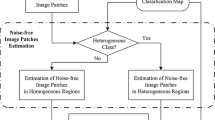Abstract
we present a novel polarimetric synthetic aperture radar (PolSAR) image compression scheme. PolSAR data contains lots of similar redundancies in single-channel and massively correlation between polarimetric channels. So these features make it difficult to represent PolSAR data efficiently. In this paper, discrete cosine transform (DCT) is adopted to remove redundancies between polarimetric channels, simple but quite efficient in improving compressibility. Sparse K-singular value decomposition (K-SVD) dictionary learning algorithm is utilized to remove redundancies within each channel image. Double sparsity scheme will be able to achieve fast convergence and low representation error by using a small number of sparsity dictionary elements, which is beneficial for the task of PolSAR image compression. Experimental results demonstrate that both numerical evaluation indicators and visual effect of reconstructed images outperform other methods, such as SPIHT, JPEG2000, and offline method.




Similar content being viewed by others
References
Aharon M, Elad M, Bruckstein A (2006) K-SVD: an algorithm for designing overcomplete dictionaries for sparse representation. IEEE Trans. Signal Process 54(11):4311–4322
Christopoulos C, Skodras A, Ebrahimi T (2001) The JPEG2000 still image coding system: an overview. IEEE Trans Consum Electron 46(4):1103–1127
Gorodnitsky IF, Rao BD (1997) Sparse signal reconstruction from limited data using FOCUSS: a re-weighed minimum norm algorithm. IEEE Trans Signal Process 45(3):600–616
Horev I, Bryt O, Rubinstein R (2012) Adaptive image compression using sparse dictionaries. IEEE IWSSIP:592–595
Hwang K, Tseng PS, Kim D (1989) An orthogonal multiprocessor for parallel scientific computations. IEEE Trans Comput 38(1):47–61
Kim BJ, Xiong ZX, Pearlman WA (2000) Low bit-rate scalable video coding with 3-D set partitioning in hierarchical trees (3-D SPIHT). IEEE Trans Circuits Syst Video Technol 10(8):1374–1387
Rubinstein R, Zibulevsky M, Elad M (2010) Double sparsity: learning sparse dictionaries for sparse signal approximation. IEEE Trans Signal Process 58(3):1553–1564
Said A, Pearlman WA (1996) A new, fast, and efficient image codec based on set partitioning in hierarchical trees. IEEE Trans Circuits Syst Video Technol 6(3):243–250
Skretting K, Engan K (2010) Recursive least squares dictionary learning algorithm. IEEE Trans Signal Process 58(4):2121–2130
Skretting K, Engan K (2011) Image compression using learned dictionaries by RLS-DLA and compared with K-SVD. IEEE International Conference on Acoustics, Speech and Signal Processing (ICASSP 2011): 1517–1520
Wallace GK (1992) The JPEG still picture compression standard. IEEE Trans Consum Electron 38(1):1008–1024
Wang Z, Bovik AC, Sheikh HR, Simoncelli EP (2004) Image quality assessment: from error visibility to structural similarity. IEEE Trans Image Process 13(4):600–612
Zhan X, Zhang R, Yin D, Huo C (2013) SAR images compression using multiscale dictionary learning and sparse representation. IEEE Geosci Remote Sens Lett 10(5):1090–1094
Zhang R, Yin D, Hu A, Hu W (2013) Remote sensing image compression based on double-sparsity dictionary learning and universal trellis coded quantization. IEEE international conference on image processing (ICIP 2013):1665–1669
Acknowledgements
This work is supported by the China Postdoctoral Science Foundation Special funded project (No.2012 T50799), the International Postdoctoral Exchange Fellowship Program 2013 by the Office of China Postdoctoral Council (No. 20130026) and the Open Research Fund of Key Laboratory of Spectral Imaging Technology by Chinese Academy of Sciences.
Author information
Authors and Affiliations
Corresponding author
Rights and permissions
About this article
Cite this article
Bai, J., Liu, B., Wang, L. et al. PolSAR image compression based on online sparse K-SVD dictionary learning. Multimed Tools Appl 76, 24859–24870 (2017). https://doi.org/10.1007/s11042-017-4640-y
Received:
Revised:
Accepted:
Published:
Issue Date:
DOI: https://doi.org/10.1007/s11042-017-4640-y




